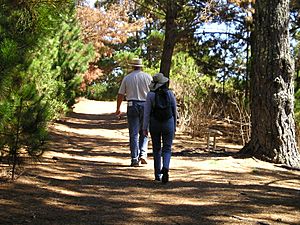Jacks Peak Park facts for kids
Jacks Peak Park is a special county park located in Monterey County, California. It's home to Jacks Peak, which is the highest point on the beautiful Monterey Peninsula. This peak rises 1,068 feet (325 meters) above the cities of Monterey and Carmel. The park covers a large area of 525 acres and is managed by the Monterey County Parks Department. It's a great place to explore nature and enjoy amazing views!
Contents
The Story of Jacks Peak Park
Jacks Peak Park has an interesting history. The land was once part of a larger area called the Pueblo Lands. A Scottish businessman named David Jack acquired these lands in 1859.
Years later, in 1964, a couple named Talcott and Margaret Pardee Bates bought 55 acres of this land. They wanted to protect it. They later sold this land to an organization called The Nature Conservancy. This group works to protect important natural areas.
Eventually, The Nature Conservancy sold the land to Monterey County. In 1971, the county bought even more acres for the park from Del Monte Properties. Finally, Jacks Peak Park officially opened its doors to the public in January 1977.
Fun Things to Do at Jacks Peak Park
Jacks Peak Park is a fantastic spot for outdoor adventures. It's a day-use park, which means you can visit during the day.
Picnics and Hiking Trails
You can enjoy a picnic with your friends or family. There are also many miles of trails perfect for hiking. Some trails even have signs to guide you. These signs help you learn about the plants and animals you see. It's like a self-guided nature tour!
Nature at Jacks Peak Park
Jacks Peak Park is very important for its unique natural environment. It's one of only three places in the world where the Monterey Pine tree grows naturally.
Meet the Monterey Pines
The Monterey Pine is a special type of tree. It's amazing to see these trees growing in their native home. They are a big part of what makes this park so unique.
Other Plants You Might See
Besides the Monterey Pines, you can find many other interesting plants here. Look for the beautiful madrone trees, which have smooth, reddish bark. You might also spot coastal scrub plants like coyote brush and California sagebrush. Other plants include black sage, ceanothus, and the common poison oak. The park is also home to grand coast live oak trees.



